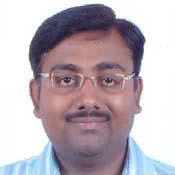
Jignesh N. Sarvaiya
Work place: Electronics Engineering Department, SVNIT, Surat, 395007, India
E-mail: jns@eced.svnit.ac.in
Website:
Research Interests: Medical Image Computing, Image Manipulation, Image Compression
Biography
Dr. Jignesh N. Sarvaiya is an Associate Professor in the department of Electronics Engineering at SVNIT, Surat. He received his B.E. from SVRCET, Surat, and M.Tech. from IIT, Bombay and Ph.D from SVNIT, Surat. His main research areas are Signal processing, Image processing and Biomedical Instrumentation. He has published various research papers in national as well as international journals and conference proceedings. He is a member of IEEE, IETE, and life member of other professional societies
Author Articles
A Review on Image Reconstruction Using Compressed Sensing Algorithms: OMP, CoSaMP and NIHT
By Hemant S. Goklani Jignesh N. Sarvaiya Fahad Abdul
DOI: https://doi.org/10.5815/ijigsp.2017.08.04, Pub. Date: 8 Aug. 2017
A sampled signal can be properly reconstructed if the sampling rate follows the Nyquist criteria. If Nyquist criteria is imposed on various image and video processing applications, a large number of samples are produced. Hence, storage, processing and transmission of these huge amounts of data make this task impractical. As an alternate, Compressed Sensing (CS) concept was applied to reduce the sampling rate. Compressed sensing method explores signal sparsity and hence the signal acquisition process in the area of transformation can be carried out below the Nyquist rate. As per CS theory, signal can be represented by alternative non-adaptive linear projections, which preserve the signal structure and the reconstruction of the signal can be achieved using optimization process. Hence signals can be reconstructed from severely undersampled measurements by taking advantage of their inherent low-dimensional structure. As Compressed Sensing, requires a lower sampling rate for reconstruction, data captured within the specified time will be obviously less than the traditional method.
In this paper, three Compressed Sensing algorithms, namely Orthogonal Matching Pursuit (OMP), Compressive Sampling Matching Pursuit (CoSaMP) and Normalized Iterative Hard Thresholding (NIHT) are reviewed and their performance is evaluated at different sparsity levels for image reconstruction.
Other Articles
Subscribe to receive issue release notifications and newsletters from MECS Press journals